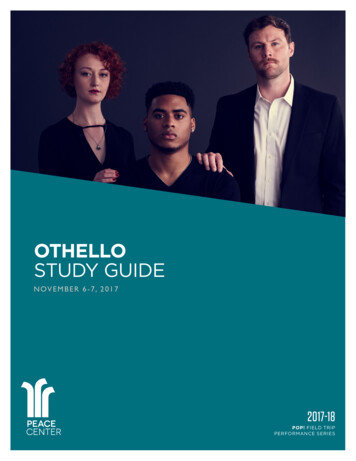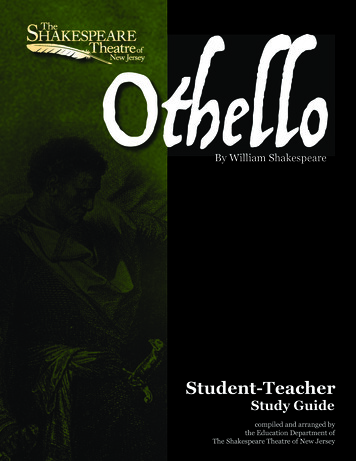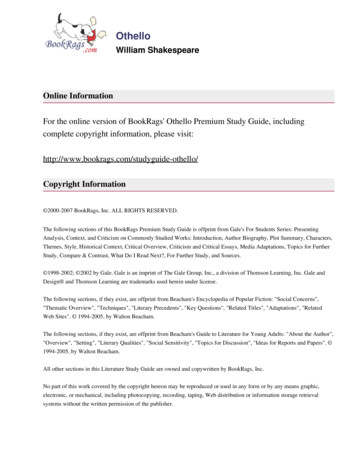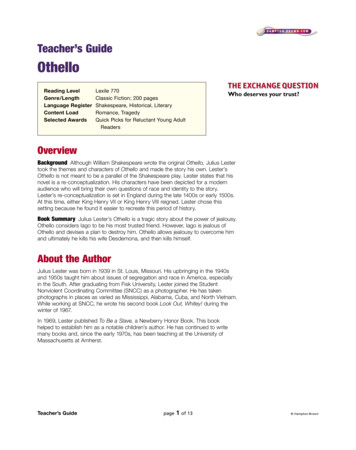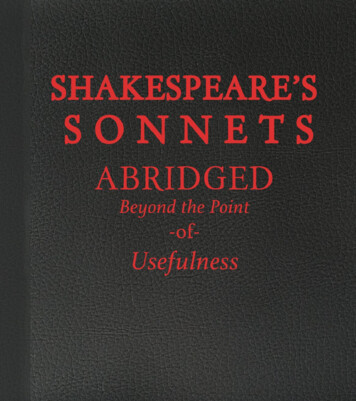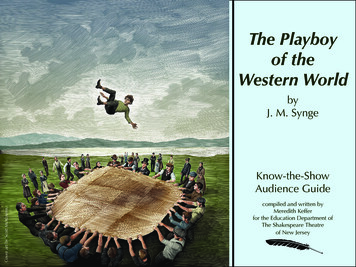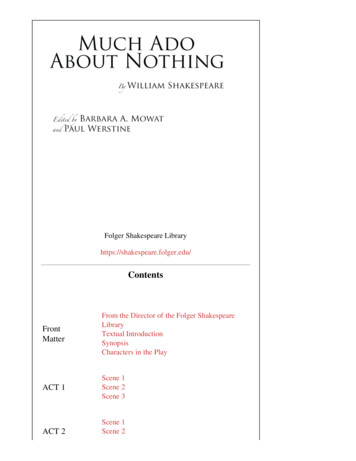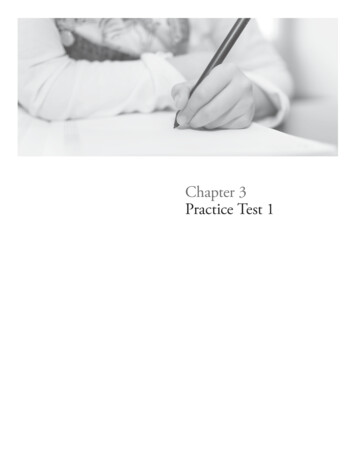
Transcription
A TEACHER’S GUIDE TO THE SIGNET CLASSIC EDITION OFWILLIAM SHAKESPEARE’SOTHELLOBy DEBRA (DEE) JAMES, University of North Carolina at AshevilleS E R I E SW. GEIGER ELLIS, ED.D.,E D I T O R S :UNIVERSITY OF GEORGIA, EMERITUSandARTHEA J. S. REED, PH.D.,UNIVERSITY OF NORTH CAROLINA, RETIRED
A Teacher’s Guide to the Signet Classic Edition of William Shakespeare’s Othello2INTRODUCTIONOthello, like all of Shakespeare’s plays, particularly the tragedies, is complex and subtly nuanced. Through its complexitiesand subtleties, Shakespeare makes us care about the characters who people this story. We understand their weaknesses andtheir strengths, their passions and their nobility. In our engagement in their lives and our pondering over what has gonewrong and why, we are given the opportunity to analyze human life both in the abstract and in the particular of our ownlives. Shakespeare’s ability to involve us in the lives and fortunes of his characters is one of the best reasons for reading,rereading, and teaching Othello.Othello has particular gifts to offer to teenagers. It is a play about passion and reason. Intense feelings are exhibited here:love, hate, jealousy, envy, even lust. Teenagers struggling with their own passions can empathize with both Roderigo’s andOthello’s plight. It is also a play that examines, as do Shakespeare’s other works, human relationships and interactions. Forteenagers in the first rush of attempting to understand how romantic relationships work and when and why they mightfail, this text provides much to ponder. In addition, studying the play gives young people a rich literary vehicle fordeveloping their critical thinking and analytical reading skills. The closer they examine this work, the richer they find it.This teacher’s guide is intended to assist you by providing a variety of ideas and activities to serve as a springboard toenrich student learning. It is divided into several parts: (1) a brief literary overview, including a synopsis and acommentary on the play; (2) suggestions for teaching the play, including activities, discussion questions, and essay topicsto be used before, during, and after reading the play; (3) ideas to extend the students’ learning beyond the play, includingways to address its themes, ideas for teaching literary analysis, techniques for using the play as a bridge to other works,and ways to use the play as part of interdisciplinary study and; (4) bibliographies and other resources.Throughout this guide activities are suggested for students of varying ability levels. You will need to select those that aremost appropriate for your classroom.OVERVIEWSYNOPSISThe play is set primarily in Cyprus. However, the opening act takes place in Venice, providing us with an understandingof the authoritarian government controlled by the Venetian senators. Also, we begin to understand Othello’s tenuousstanding in Venice, as well as Desdemona’s privileged background.The first scenes introduce the primary plot, beginning outside Brabantio’s house with Iago already intent uponmanipulation and trouble-making. He encourages Roderigo to rouse Brabantio, Desdamona’s father, and tell him of herelopement with Othello. Iago makes the announcement as alarming and disruptive as possible. Both Iago and Roderigoreveal their motivation: Roderigo’s passion for Desdemona and Iago’s appetite for revenge on Othello for choosingMichael Cassio over him as his second in command. Although Brabantio and Othello had been friends, or at least amiableacquaintances, Brabantio’s first thought is that his daughter would never have done this of her own free will—Othellomust have used witchcraft and potions.The secondary plot, introduced in the following scene, is that the Turks have taken a fleet to Cyprus, and the senatorswant to send Othello as the best and most experienced general to defend it. The Turks’ threat to Venetian civilizationechoes Brabantio’s concerns about what he interprets as Othello’s barbarian threat to his civilized daughter; he wants thepowerful senators to condemn Othello for wooing her. However, Desdemona declares that her love for the Moor is freeof any external influence.After Desdemona’s declaration all attention is returned to the attack on Cyprus. Othello is ordered to leave Veniceimmediately. Ironically, he commends Desdemona into Iago’s keeping and requests that she be allowed to come to himin Cyprus. Brabantio warns Othello that if Desdemona deceived her father she could also be false to her husband. At theend of the act, Iago persuades Roderigo to abandon his plans to kill himself over Desdemona and come to Cypressdisguised and ready seek revenge on Cassio and Othello.The next act opens with a conversation that tells of the Turks’ drowning in a storm, thus ending their threat to Cyprus.Cassio arrives, and we learn that Othello’s ship is still at sea. Desdemona and her entourage, including Iago, appear shortlythereafter; all await news of Othello. Othello appears and a tender moment of reunion with Desdemona ensues. Iago is
A Teacher’s Guide to the Signet Classic Edition of William Shakespeare’s Othello3ordered to take over the watch of the city. He seeks Roderigo’s help in his plot to undo Cassio. The plan works smoothly—Cassio gets drunk and fights with Roderigo and one of the Cypriot leaders. The fight arouses Othello. Based on Iago’sexplanation, Othello dismisses Cassio and names Iago his replacement. Iago, encouraging Cassio to seek Desdemona’sassistance in returning to Othello’s favor, begins slowly poisoning Othello’s mind by making him think that Desdemonais illicitly involved with Cassio.In Act III Iago’s plot progresses. Cassio asks Desdemona to plead his case to Othello. She freely and happily accepts hissuit and pledges herself to urge his case relentlessly. In the meantime Iago continues to poison Othello’s mind. Othellodemands visual proof:Villain, be sure thou prove my love a whoreBe sure of it; give me ocular proof;Or, by the worth of mine eternal soul,Thou hadst been better have been born a dogThan answer my naked wrath.(III, iii, 356-360)Iago quickly seizes the opportunity. Othello has given Desdemona a special handkerchief, a family heirloom passed downfrom his mother to his bride. Iago gets the handkerchief from Emilia, his wife and Desdemona’s attendant. Emilia isunaware of her husband’s intent. Iago plants the handkerchief in Cassio’s rooms. At Iago’s urging Othello asks Desdemonafor it. Worried because it seems to mean so much to her husband, Desdemona lies and says she doesn’t have it at themoment. This arouses Othello’s doubt and distrust.The next act opens with Iago plotting with Roderigo to kill Cassio. Iago continues to manipulate both Othello andRoderigo, pushing each of them to murder—even persuading Othello to strangle rather than poison Desdemona. Anoverwrought Othello has a seizure that Cassio witnesses. Iago uses this as an opportunity to call Othello’s reason intoquestion with visitors from Venice, one of whom is Desdemona’s relative. Othello can no longer contain his passionateanger towards Desdemona and publicly chides her and strikes her. Unable to get an admission of guilt from his wife, heturns to her attendant. When Othello questions Emilia about her mistress’s habits, she staunchly defends Desdemona’svirtue, but Othello will not accept her testimony.The final act climaxes in the revelation of Iago’s multi-faceted scheme. Emilia, Roderigo, and Desdemona are its earlycasualties. Cassio, though intended to die, survives. Othello finally confronts the truth about Iago’s manipulation andDesdemona’s innocence and kills himself. The story ends with the witnesses contemplating the tragic tale they must tellthe Venetian court.COMMENTARYBecause Othello is considered by many to be one of Shakespeare’s major tragedies, criticism of it is as complex as the playitself. Some call it a modernized Morality play in which the characters are primarily symbolic. This criticism centers onthe characters’ fall from innocence—the snake fouling the Garden—caused by Iago’s manipulation of Othello. Othercritics examine the play in terms of the clash of cultures: military vs. civilian, Moorish vs. Venetian, barbaric vs. civil.Likewise, the themes of prejudice and of unbridled jealousy are the focus of commentary about the play. Others view theplay as a story of human frailty — the story of the fall of a man of noble bearing and sincere passion and the destructionof an innocent and real love.Othello is equally, however, a story of malevolence and manipulation. One of the most intriguing characters in Shakespeare’sroll call of villains is Iago. From the beginning of the play until the final scenes, Iago plots and maneuvers to bring thepeople around him, especially Othello, to doom and destruction. Iago’s tactics are revealed in the opening scene as hedraws first Roderigo and then Brabantio into his service. By presenting the relationship between Othello and Desdemonain the crudest sexual terms, he rouses Brabantio and Roderigo to become willing workers in his scheme to revenge himselfon the Moor. Just as clearly he enjoys each man’s alarm and anguish. His subsequent conversations with Roderigo, inwhich he draws him ever deeper into his plot, prepare us for the cunning with which he begins his cruel work on Othello.By contrast, Othello is clearly not a dissembler. He is forthright with the senators when asked about his relationship withDesdemona. Instead of claiming that she was attracted by his noble bearing and grace, he tells them that she was firstcaught by his stories of the true adventures of his life and then drawn on to love through her pity for the trials he hadendured. He is not a man who plays games. He accurately sums up his own character:
A Teacher’s Guide to the Signet Classic Edition of William Shakespeare’s Othello4.Then must you speakOf one that loved not wisely, but too well;Of one not easily jealous, but being wrought,Perplexed in the extreme; of one whose hand,Like the base Judean, threw a pearl awayRicher than all his tribe.(V,ii, 339-344)Othello and Iago, then, are the two characters at the crux of the play. The major action of the play is the tightening ofIago’s net around the noble Moor and the decay of the Moor’s nobility. It is this clash and the vulnerabilities of the humansinvolved that many critics agree provide the basis for the continuing interest and compelling attraction of Othello.BEFORE READINGThis guide combines literary, dramatic, and cultural approaches to the teaching of Othello. The suggested activities engagestudents with the language and formal elements of the play: plot, character, setting, and theme. They also help bring theplay to life for students by involving them in its dramatic action. In addition, they assist students in understanding thecultural and social context of the play. An array of ideas for visualizing, acting out, reading aloud, and reinterpreting theroles are included. An effort has been made, too, to keep students involved in thinking, reading, writing, listening, andspeaking about various aspects of the play. Students become a part of the Venetian scene and compare the world of Othelloto their own contemporary world. Finally, the activities show how teachers in subjects other than the language arts canaddress the play in their classrooms. Materials included in the bibliography provide a wealth of teaching ideas tosupplement those in this guide. They also direct teachers to other literature that can be used in thematic units.UNDERSTANDING THE CULTURAL CONTEXTThese activities are designed for the language arts classroom, but can be equally effective in social studies. They helpstudents understand the cultural and social context of the play.1.In order for students to understand the subtleties of the play, they should understand something about the culture aboutwhich it was written and in which it was produced. Pair or divide students into groups of three to do mini-researchprojects, primarily from encyclopedias and specialized reference texts. A quick turn around time, 24 to 48 hours, will keepstudents from bogging down in this preliminary activity and allow them to focus on the play itself. Students can report orallyon the material they gather. The topics should all originate from the play. More than one group can tackle the same topic: Who were the Moors? Who were the Venetians? How were the Moors/Venetians regarded in Shakespeare’s day? What were the military duties of ranked officers? What was the military hierarchy? What was the role of women? What was expected of a daughter? What was expected of a bride? What relationships between men and women were considered above reproach? What rules for getting married existed at the time of the play? What were the rules of courtship?
A Teacher’s Guide to the Signet Classic Edition of William Shakespeare’s Othello2.3.4.5Have students examine cultural rules by which they live and compare and contrast these rules to the ones of Othello’s time.Have them think and/or write about the following topics before discussing them: What rules dictate the behavior of young men and women in relationships today? Name a situation in which the rules have clearly been violated. That is, what are things “nice girls” just don’t do?What are things “nice boys” just don’t do? Why do these rules exist? Do you think they just apply locally or even just in your school? What are the possibleconsequences of breaking these rules?Divide students into groups to brainstorm situations in which cultural rules were unclear or were very different from whatthey expected. Each group should come up with one or two situations and list: the actual rule, the rule as interpreted incorrectly, and where help could be found.Show one scene from the Lawrence Fishburne video of the play (perhaps the scene where Othello strikes Desdemona).Have students analyze: the rule that seems to be operating or the rule that seems to
turns to her attendant. When Othello questions Emilia about her mistress’s habits, she staunchly defends Desdemona’s virtue, but Othello will not accept her testimony. The final act climaxes in the revelation of Iago’s multi-faceted scheme. Emilia, Roderigo, and Desdemona are its early casualties. Cassio, though intended to die, survives. Othello finally confronts the truth about Iago’s manipulation and
